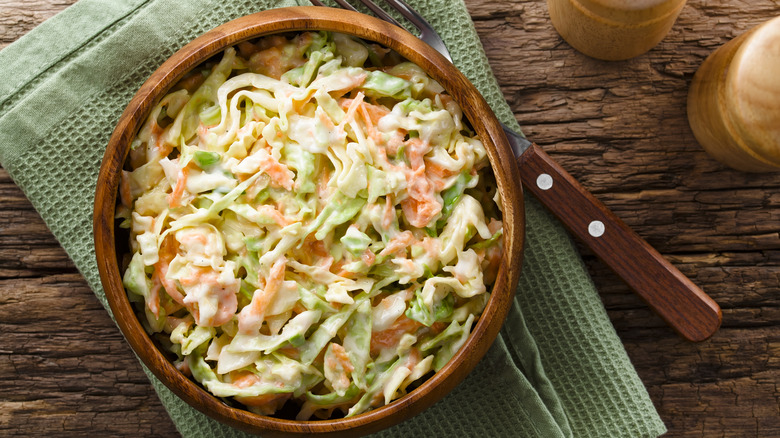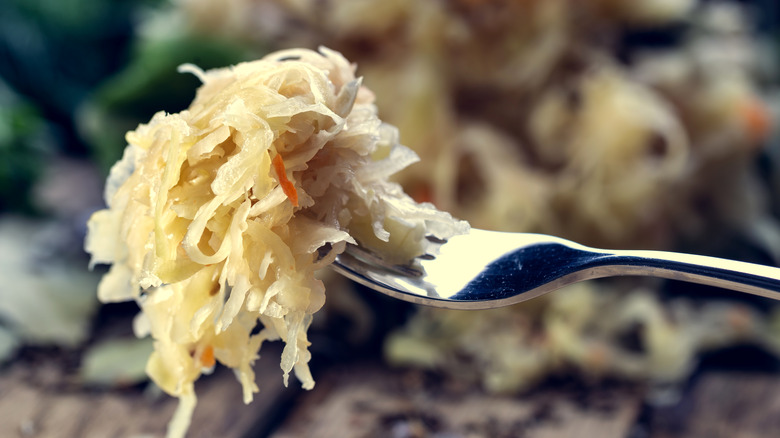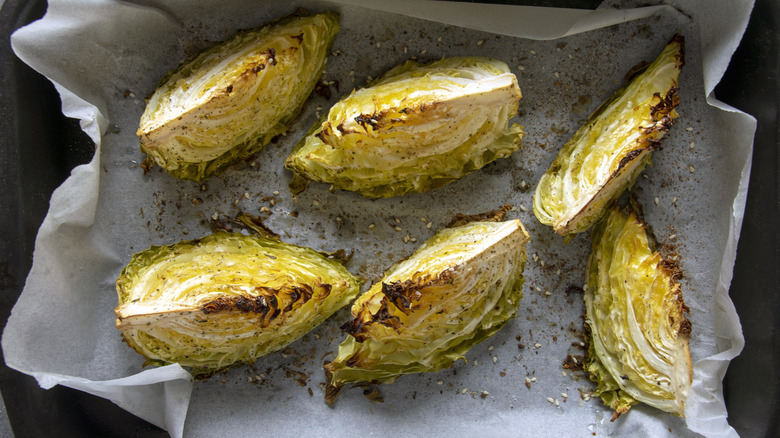The Salt Trick To Prevent Soggy Cabbage While Cooking
"Soggy" and "coleslaw" are two words that should never go together. Primarily because those sounds together provoke the same uncomfortable squirm as the word "moist", but also because there's nothing less appetizing than a soggy coleslaw. Luckily, this can easily be fixed so that these words are never paired again by simply pre-salting your cabbage and draining it before you assemble the best coleslaw ever or your favorite cabbage dish.
The reason that your cabbage is turning your favorite dishes into waterlogged messes is that the cabbage is full of water. Cabbage is made up of about 92% water. This is the same reason why the only two ingredients needed for sauerkraut are cabbages and salt. The salt has a wonderful ability to draw out all of that excess moisture and uses it as a brining liquid. The same thing will also occur when you cook cabbage or add salt or acid in the form of your coleslaw dressing. The cabbage starts to break down, and the water ends up in your food. This is one of the reasons that cabbage typically gets overlooked as a vegetable; it seems like it's too hard to work with. To avoid this all you need to do is salt your cabbage shortly before the final preparation, and drain off all the excess moisture.
Why salt draws out moisture and how to use it to your advantage
The reason that salt can draw so much moisture out of your cabbage is due to a scientific process known as osmosis. Osmosis is a chemical process where water molecules move through a permeable wall into a substance or environment that has a lower concentration of water molecules. In this case, the water is moving through the cabbage's cell walls to the arid salt cells.
This is also the same scientific principle that helps create pickled vegetables. Pickled vegetables have a natural defense against bacteria because they are unable to replicate after the moisture has been drawn out of the vegetables.
To work the magic of osmosis on your cabbage you'll need to shred all of it first. Then, put it in a bowl with a tablespoon of salt per head of cabbage used and let it rest for one to two hours. Then drain off the water, and dry your cabbage with a paper towel before continuing with your recipe. This will also break down the cabbage's texture slightly, but it will still allow it to keep a nice crisp bite.
Best ways to prepare cabbage once you've drained it
Once you have drained the cabbage of its water, there is a never-ending number of ways to use it. One of the best recipes for converting cabbage haters into fans is oven-roasted cabbage. Giving sliced wedges of cabbage a quick roasting session in the oven will help them to caramelize and get nice and crispy. Instead of getting soggy and overcooked, the cabbage will have a nice crisp texture and a more complex flavor than raw cabbage.
You can also infuse cabbage with tons of flavor by braising it. Just add your salted cabbage to a pot filled with broth, wine, or another braising liquid along with your preferred spices. Cabbage's hardy nature helps it hold up well to this style of cooking. You can also just sautee your cabbage in a pan with lemon and garlic to quickly add a lot of flavor to this delicious cruciferous vegetable.
If you also forget to return to your cabbage after you've salted it, then you might as well just see things through and make sauerkraut. You may need to add more salt to make a proper brine, but once you do it's an easy measure to put it all into a sealable jar, add weight, and give it time to properly ferment.


